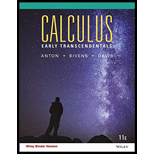
Use the Divergence Theorem to find the flux of F across the surface
Want to see the full answer?
Check out a sample textbook solution
Chapter 15 Solutions
CALCULUS EARLY TRANSCENDENTALS W/ WILE
Additional Math Textbook Solutions
Calculus 2012 Student Edition (by Finney/Demana/Waits/Kennedy)
Single Variable Calculus: Early Transcendentals (2nd Edition) - Standalone book
Precalculus Enhanced with Graphing Utilities (7th Edition)
Precalculus
University Calculus: Early Transcendentals (4th Edition)
University Calculus: Early Transcendentals (3rd Edition)
- Determine the flux of F(x, y, z) = < −x2 + x, y, 8x3 − z + 9 > across the surface with an upward orientation. Let the surface be the portion of the paraboloid z = 9 − 4x2 −4y2 on the first octant above the plane z = 1. (note: do not use gauss' theorem)arrow_forwardLet F(x, y, z)=(v)i+(x)j+(z²)k. Find the flux of F across the positively oriented closed surface S where S is the surface of the sphere x + y +z² = 4.arrow_forwardLet F(x,y,z) = ztan1(y2) i + z³In(x2 + 4) j + z k. Find the flux of F across the part of the paraboloid x² + y2 + z = 6 that lies above the plane z = 2 and is oriented upward.arrow_forward
- Find the flow of F=xzi-yk through the upper part of plane z-1 in the x + y +2 = 4sphere.arrow_forwardfind the outward flux of F across the boundary of D. F =-2x i - 3y j + z k D: The upper region cut from the solid sphere x2 + y2 + z2 <=2 by the paraboloid z = x2 + y2arrow_forward4. Let F²i+ (2xy+xa) j+zk. Let C be the circle x² + y² = 1 and S the disk 2² + y² ≤ 1 within the plane z = 0. (a) Determine the flux of F out of S. (b) Determine the circulation of F around C. (c) Find the flux of VX F. Verify Stokes' theorem directly in this case.arrow_forward
- Use a parameterization to find the flux SF-n do of F=2²i+xj-3zk in the outward direction (normal away from S the x-axis) across the surface cut from the parabolic cylinder z=4-y² by the planes x=0, x=1, and z=0. The flux is harrow_forwardLet F = -9zi+ (xe"z – 2xe*)}+ 12 k. Find f, F•JÃ, and let S be the portion of the plane 2x + 3z = 6 that lies in the first octant such that 0 < y< 4 (see figure to the right), oriented upward. Can Stokes' Theorem be used to find the flux of F through S? Clearly answer yes or no, and then briefly explain your answer.arrow_forwardConsider the space curve represented by the intersection of the surfaces. Represent the curve by a vector-valued function r(t) using the given parameter. r(t) = Surfaces z = x² + 2y², x+y=0 Parameter x = tarrow_forward
- Find the flux of F=z2kF=z2k upward through the part of the sphere x2+y2+z2=a2x2+y2+z2=a2 in the first octant of 3-space.arrow_forwardLet F(x, y, z) = xzi+yzj + xyk, Surface S is the part of the sphere x² + y² + z² = 4 that lies inside the cylinder x² + y² = 1 and above the xy-plane. Find a vector equation of the boundary curve C. (b) Compute for FdR (c) Compute for C F.Tdsarrow_forwardUse the Divergence Theorem to find the flux of F(x, y, z) = 3x³i + 3x²yj + 24xyk across the surface of the solid bounded by z = 4 - x², y + z = 5, z = 0, and y = 0 with outward orientation. NOTE: Enter the exact answer. Φ =arrow_forward
 Calculus: Early TranscendentalsCalculusISBN:9781285741550Author:James StewartPublisher:Cengage Learning
Calculus: Early TranscendentalsCalculusISBN:9781285741550Author:James StewartPublisher:Cengage Learning Thomas' Calculus (14th Edition)CalculusISBN:9780134438986Author:Joel R. Hass, Christopher E. Heil, Maurice D. WeirPublisher:PEARSON
Thomas' Calculus (14th Edition)CalculusISBN:9780134438986Author:Joel R. Hass, Christopher E. Heil, Maurice D. WeirPublisher:PEARSON Calculus: Early Transcendentals (3rd Edition)CalculusISBN:9780134763644Author:William L. Briggs, Lyle Cochran, Bernard Gillett, Eric SchulzPublisher:PEARSON
Calculus: Early Transcendentals (3rd Edition)CalculusISBN:9780134763644Author:William L. Briggs, Lyle Cochran, Bernard Gillett, Eric SchulzPublisher:PEARSON Calculus: Early TranscendentalsCalculusISBN:9781319050740Author:Jon Rogawski, Colin Adams, Robert FranzosaPublisher:W. H. Freeman
Calculus: Early TranscendentalsCalculusISBN:9781319050740Author:Jon Rogawski, Colin Adams, Robert FranzosaPublisher:W. H. Freeman
 Calculus: Early Transcendental FunctionsCalculusISBN:9781337552516Author:Ron Larson, Bruce H. EdwardsPublisher:Cengage Learning
Calculus: Early Transcendental FunctionsCalculusISBN:9781337552516Author:Ron Larson, Bruce H. EdwardsPublisher:Cengage Learning





